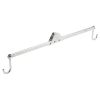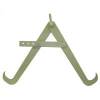CollinLeon
member
Back in the old days when we would get a deer, we would just use a gambrel made out of some rope loops and a short piece of 2x4 for a spacer. Yeah, we weren't exactly high tech back then. I've recently seen a bunch of other designs out there and was curious what others might be using...
I've seen one made with a metal spreader bar and wire cable used as loops for the legs:

I've seen ones that were basically a straight bar that folded in half and had hooks at the end:

I've seen ones that basically looked like a clothes hangar with hooks on the end:

I've seen adjustable width ones like this:

I've seen ones that were basically made from chain with a metal spreader bar:

Or DIY ones made from pipe and wire cable like this:

And even adjustable "t-hanger" designs like this:

So, the survey question for today is:
What type do you use for deer / hogs / elk / whatever and why do you think it is better than the others?
I've seen one made with a metal spreader bar and wire cable used as loops for the legs:

I've seen ones that were basically a straight bar that folded in half and had hooks at the end:

I've seen ones that basically looked like a clothes hangar with hooks on the end:

I've seen adjustable width ones like this:

I've seen ones that were basically made from chain with a metal spreader bar:

Or DIY ones made from pipe and wire cable like this:

And even adjustable "t-hanger" designs like this:

So, the survey question for today is:
What type do you use for deer / hogs / elk / whatever and why do you think it is better than the others?
Last edited:





